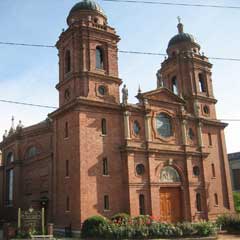American basilica's beauty ranks with European cathedrals
By Lorraine Williams, Catholic Register Special ASHEVILLE, N.C. - The picturesque city of Asheville in North Carolina is nestled in the foothills of the Appalachian mountains. Among its many tourist attractions is a remarkable spiritual gem — the Basilica of St. Lawrence.
ASHEVILLE, N.C. - The picturesque city of Asheville in North Carolina is nestled in the foothills of the Appalachian mountains. Among its many tourist attractions is a remarkable spiritual gem — the Basilica of St. Lawrence. Located in the city’s core, its striking copper-covered dome, which is the focus of attention when first viewing the basilica, and exquisite interior give it a place of honour among American houses of worship.
Completed in 1909, the Basilica of St. Lawrence is one of Asheville’s architectural treasures and spiritual anchors. Designed by Rafael Guastavino, who patented the “Tile-arch system,” and Richard Sharpe Smith, it is a magnificent sight to view with the copper-clad top, shaped like an egg and now of an age where the roof has taken on a patina of green — speaking to the spirit of new life and resurrection.
When one stands in the interior and looks up, it seems an architectural miracle that a span 16 by 25 metres has no supports. This is due to the genius of Guastavino (whose crypt is contained in the Basilica) who developed this technique, making it the largest freestanding elliptical dome in North America.
The parish had humble beginnings in 1886 when Fr. J. J. O’Connell first celebrated Mass on the summit of Mount Mitchell. Two small churches were built, before the Marion brothers, Frs. Peter and Patrick, were assigned the task of erecting a permanent church. It was completed in 1909.
Guastavino, who was one of America’s outstanding architects, invested his design not only with professional diligence but also with deep spirituality. It was purposely constructed of red brick, terrazzo and stone, rendering it fireproof. There are no beams of wood or steel in the entire construction. All the walls, floors, ceilings and pillars are of tile or other masonry material. A native of Spain, he introduced many Spanish features into the interior. The magnificent three-tiered main altar carved from walnut is from Spain. The backdrop is a moving carving of Christ on the cross, with Mary and disciple John standing beneath. The artistic brush strokes on their robes bring them alive to the viewer. The altar facing the congregation features a terracotta panel resembling Da Vinci’s Last Supper.
The chapel originally dedicated to St. Joseph is now used for Perpetual Adoration of the Blessed Sacrament. An exquisite jeweled monstrance displays the Host. A touching stained glass window of the Nativity is above this altar, and surrounding the latter are six statues: Sts. Francis Cabrini (the first naturalized American saint), Therese of Lisieux, Joseph, Martin de Porres, Jude and the Sacred Heart.
The chapel of the Blessed Virgin on the left hand side of the main altar is done in the traditional blue. Referred to as the basilica’s “piece de resistance,” it is dominated by a marble statue of Mary (similar in concept to Murillo’s Assumption of Mary). Two angels surround Mary and above her seven doves represent the gifts of the Holy Spirit. On the tri-level altar (also from Spain) is a porcelain sculpture of the Crucifixion on an onyx background.
Finally, yet another outstanding feature is its wealth of stained glass windows. They depict both Old and New Testament stories.
Reluctantly, I left the basilica, unwilling to detach myself from the beauty that surrounded me. I was reminded of the most famous cathedrals of Europe, whose purpose in medieval times was to depict for the mainly illiterate faithful the mysteries of our Catholic faith through the medium of art. The difference in Asheville, however, is that unlike those ancient cathedrals which are dimly lit and darkened over the years with dust and dirt, at St. Lawrence Basilica everything is fresh and restored, waiting for the visitor to be uplifted by the scenes presented which have been executed with the deepest reverence.
St. Lawrence Basilica, named after the last of seven deacons to be martyred for the faith in 258, is a compelling evangelizing and educational instrument in the heart of North Carolina.
(Williams is a Contributing Editor to The Catholic Register.)
Please support The Catholic Register
Unlike many media companies, The Catholic Register has never charged readers for access to the news and information on our website. We want to keep our award-winning journalism as widely available as possible. But we need your help.
For more than 125 years, The Register has been a trusted source of faith-based journalism. By making even a small donation you help ensure our future as an important voice in the Catholic Church. If you support the mission of Catholic journalism, please donate today. Thank you.
DONATE